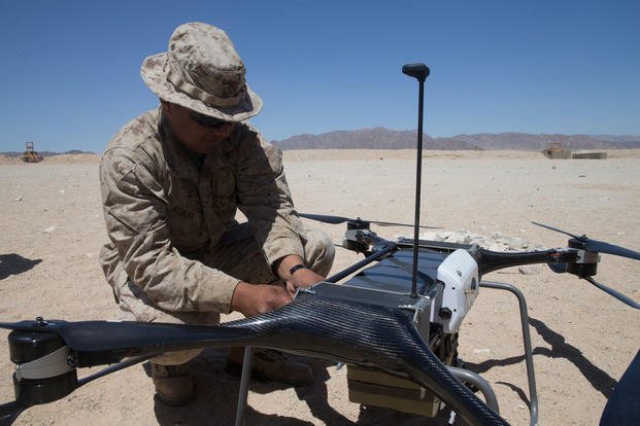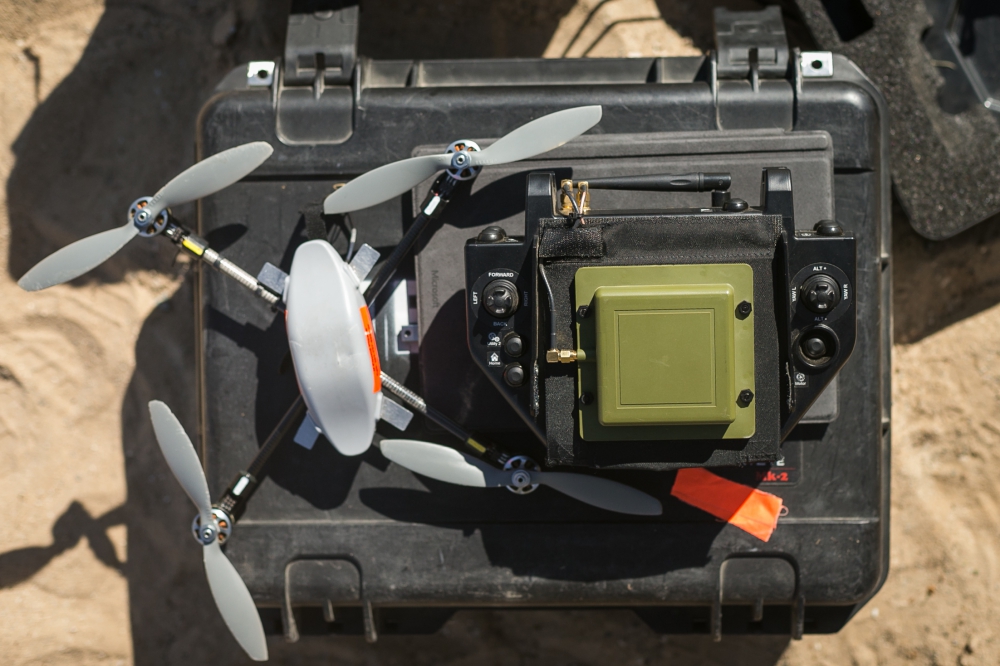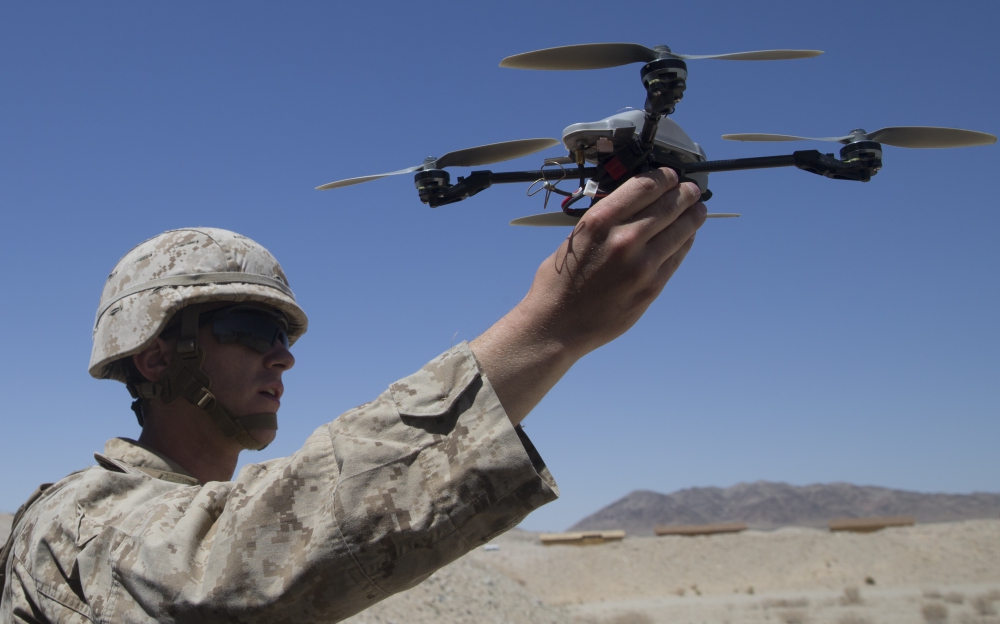The US Marine Corps has shelved several new, small drones – at least temporarily – amid a Pentagon ban and assessment on the cybersecurity of commercial, off-the-shelf, unmanned aerial systems, a service spokesman told USNI News.
The USMC has been forced to ground COTS, it has been fielding to infantry units “until the DoD identifies and fields a solution to mitigate known cybersecurity risks,” according to a recent Department of Defense policy memo written by Deputy Defense Secretary Patrick M. Shanahan.
“The DoD Inspector General found that the DoD has not implemented an adequate process to assess cybersecurity risks associated with using commercial-off-the-shelf (COTS) Unmanned Aerial Systems,” the memo states.
The Marine Corps officials are asking defense officials to exempt eight systems so Marines can continue to use and train with the drones, Captain Joshua Pena, a Marine Corps Combat Development Command spokesman, told USNI News Monday.
Pena said exemption requests were being drafted and reviewed by senior leaders and for submission to the Office of the Undersecretary of Defense for these systems:
- Black Hornet 2 and Black Hornet 3, manufactured by FLIR Systems, Inc.
- SkyRanger (Aeryon Labs)
- InstantEye Mk-2 Gen-3 and InstantEye Mk3 (Physical Sciences Inc.)
- Indago (Lockheed Martin)
- Phantom 3 Pro and DJI Phantom 4 Pro (DJI).
The Mk-2 Gen-3 InstantEye is a centerpiece of the “Quads for Squads” initiative driven by the commandant, Gen. Robert Neller, to equip infantry units with innovative, high-tech capabilities to make Marines more lethal and effective in a cyber battle space, including micro and small drones. The small quadcopter, manufactured by InstantEye Robotics, a division of Andover, Mass.,-based Physical Sciences, Inc., is getting fielded to squads across the Marine Corps’ three infantry divisions.

U.S. Marine Corps Lance Cpl. Miguel Rivera, with Combat Logistics Battalion 8, Combat Logistics Regiment 2, 2nd Marine Logistics Group, performs a pre-flight test on the TRV-50 quadcopter during an operations check for Marine Corps Warfighting Laboratory as part of Integrated Training Exercise 3-18 on Marine Corps Air Ground Combat Center, Twentynine Palms, Calif., April 29, 2018. (U.S. Marine Corps photo/Scott Jenkins)
The US Navy and Marine Corps had ordered an additional 800 additional 800 InstantEye Mk-2 GEN3-A0 sUAS systems in February this year. The InstantEye family of products includes the Mk-2 GEN4, which is capable of carrying payloads up to 4 pounds; the mid-sized, highly agile Mk-2 GEN3 can carry payloads up to 1.5 pounds; and the palm-sized integrated Mk-2 GEN5, with advanced vehicle-borne computer processing power that will allow the system to adapt to future capability needs.
InstantEye is a centrepiece of the ‘Quads for Squads’ initiative to equip infantry units with high-tech capabilities to make Marines more lethal and effective in a cyber-battle space, including micro and small drones, USNI reported.

U.S. Marine Corps Lance Cpl. Miguel Rivera, with Combat Logistics Battalion 8, Combat Logistics Regiment 2, 2nd Marine Logistics Group, performs a pre-flight test on the TRV-50 quadcopter during an operations check for Marine Corps Warfighting Laboratory as part of Integrated Training Exercise 3-18 on Marine Corps Air Ground Combat Center, Twentynine Palms, Calif., April 29, 2018. (U.S. Marine Corps photo/Scott Jenkins)
But the Pentagon’s decision has forced Marines to stop using InstantEye until it can get the green light from the Pentagon. It’s considered a COTS product, Pena said, and “the system has been grounded.” The ban “also applies to all UAS ground command and control elements including smartphones or tablets with associated software and hardware,” he added.
So far, the first battalions have received 600 of the Marine Corps’ initial buy of 800 Mk-2 Gen-3 drones for the “Quads for Squads,” and the remaining 200 are pending shipment, he said. “The policy has not affected that schedule,” he added.
In suspending all COTS unmanned aerial systems, Shanahan cited a May 14 DoD inspector general finding that “the DoD has not implemented an adequate process to assess cybersecurity risks associated with using COTS UAS.”
Shanahan noted his authority to approve any “requests for exemptions, on a case by case basis, to support urgent needs.” He directed military officials and agencies to report to him within 30 days “to identify and account for all COTS UAS.”
The memo doesn’t indicate what prompted the suspension of the military’s use of drones, which include some popular commercially-available drones sold to consumers and manufactured by US or foreign companies.
However, last month, Sen. Chris Murphy, D-Conn., wrote to Defense Secretary James Mattis about “a potential national security threat” in products manufactured by DJI, or Da-Jiang Innovations, a technology company based in China.
Top Photo: US Marine Corps 2nd Lt. Michael Francica, with Combat Logistics Battalion 8, Combat Logistics Regiment 2, 2nd Marine Logistics Group, pilots an InstantEye quadcopter during an operations check for Marine Corps Warfighting Laboratory as part of Integrated Training Exercise 3-18 on Marine Corps Air Ground Combat Center, Twentynine Palms, Calif. on April. 29, 2018. US Marine Corps Photo
Sources: USNI News; Defense World

